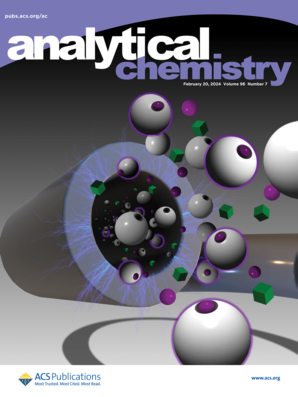β-Galactosidase-Mediated, Mn2+-Activated CRISPR/Cas12a Cascade Reaction for Immunosorbent Assay of Carbendazim
IF 6.7
1区 化学
Q1 CHEMISTRY, ANALYTICAL
引用次数: 0
Abstract
The CRISPR/Cas12a system is an emerging enzymatic tool for the development of enzyme-linked immunosorbent assay (ELISA) methods, owing to its robust signal amplification capability. Currently, most CRISPR/Cas12a-based ELISA approaches rely on strategies that convert target detection into nucleic acid analysis. This report presents a novel enzymatic cascade reaction for signal transduction and amplification in the development of a CRISPR/Cas12a-based ELISA method, utilizing β-galactosidase (β-gal)-mediated activation of the CRISPR/Cas12a system. Carbendazim (CBD), a widely used and versatile broad-spectrum benzimidazole fungicide, was chosen as the model analyte. In the absence of CBD, streptavidin-labeled β-gal is captured by a biotinylated secondary antibody immobilized on the microplate. The captured β-gal catalyzes the hydrolysis of p-aminophenyl β-D-galactopyranoside to generate p-aminophenol. This compound subsequently facilitates the decomposition of MnO2 nanosheets, leading to the generation of Mn2+ ions. The Mn2+ ions modulate the activity of the CRISPR/Cas12a system, thus producing high fluorescence in the detection solution. In the presence of CBD, the amount of β-gal captured on the microplate is reduced, thereby preventing effective cleavage of the reporter molecule by Cas12a, which results in a low fluorescence signal. After systematically optimizing experimental conditions, the developed method successfully detected CBD, demonstrating high sensitivity, selectivity, and applicability in complex food matrices. In comparison to the traditional nucleic acid-activated CRISPR/Cas12a-based ELISA method, our approach, which integrates β-gal-mediated, Mn2+-activated CRISPR/Cas12a cascade reactions into ELISA, exhibits superior analytical performance, thereby broadening the applicability of CRISPR/Cas12a for sensitive and convenient small-molecule analysis.

求助全文
约1分钟内获得全文
求助全文
来源期刊

Analytical Chemistry
化学-分析化学
CiteScore
12.10
自引率
12.20%
发文量
1949
审稿时长
1.4 months
期刊介绍:
Analytical Chemistry, a peer-reviewed research journal, focuses on disseminating new and original knowledge across all branches of analytical chemistry. Fundamental articles may explore general principles of chemical measurement science and need not directly address existing or potential analytical methodology. They can be entirely theoretical or report experimental results. Contributions may cover various phases of analytical operations, including sampling, bioanalysis, electrochemistry, mass spectrometry, microscale and nanoscale systems, environmental analysis, separations, spectroscopy, chemical reactions and selectivity, instrumentation, imaging, surface analysis, and data processing. Papers discussing known analytical methods should present a significant, original application of the method, a notable improvement, or results on an important analyte.
 求助内容:
求助内容: 应助结果提醒方式:
应助结果提醒方式:


